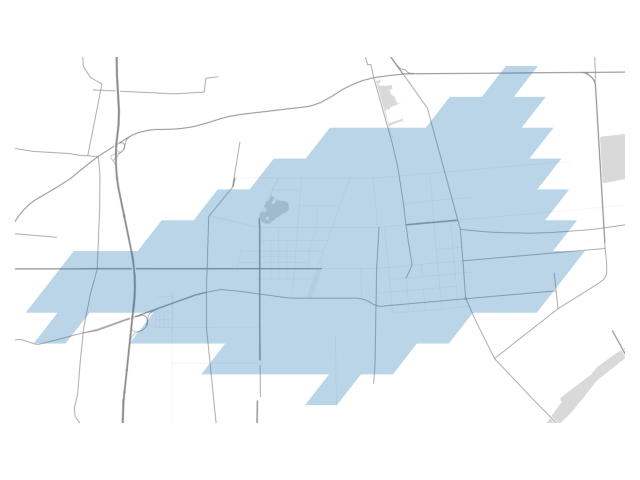Binzhou: city in Shandong, China


What exactly constitutes the spatial extent of the city? For these aggregations, we used the Global Human Settlement Layer Urban Center Database (GHS-UCDB) to define the boundaries of the city. These cities -- or urban centers -- cover areas that are densely populated and built-up, and so may extend beyond the spatial borders of these cities that we may be familiar with. The GHS area is shaded in blue.
View Binzhou, China on the sprawlmap


Most recent snapshot: Taking into account the entire (i.e. aggregate) street network in Binzhou as of 2014, the overall level of street-network sprawl is 0.33, which is very well-connected.
Trends in street network construction: The SNDis of street construction for the respective time periods are 0.21, -0.2, 1.14 and 0.37. Disconnectivity in street construction in Binzhou follows a zig-zag trend. In 1976-1990, street construction was most disconnected, while construction was most connected in 1991-2000.
Quantity of street network construction: The street network in Binzhou spans a total of 609 kilometers. It is dominated by roads constructed in 2001-2014. These roads have an SNDi of 0.37, which is very well-connected.
Effect on the aggregate network: New construction in each period adds to the total stock of streets, but does not change streets that have already been built. Therefore, it has a limited effect on the street network as a whole. The SNDis of the aggregate street network in the respective time periods are 0.21, -0.15, 0.26 and 0.33. The SNDi of the aggregate street network in fell at first, but Binzhou has worsened in disconnectivity since 1990.

Binzhou and Shandong do not follow the same trend in the disconnectivity of their street network constructions. The SNDi in Binzhou followed a zig-zag trend with an overall increase, while the SNDi of street constructions in Shandong followed a zig-zag trend with an overall increase.
How do development practices in Binzhou fare in comparison to others in Shandong? Most recently in 2001-2014, street construction in Binzhou was the 82nd-most disconnected out of the 113 cities in Shandong. Its position in the ranks since 1975 has fallen; relative to other cities in Shandong, street construction in Binzhou has become more connected. Binzhou ranked 58th in 1975, 92nd in 1976-1990, 41st in 1991-2000 and 82nd in 2001-2014.
Binzhou and China do not follow the same trend in the disconnectivity of their street network constructions. The SNDi in Binzhou followed a zig-zag trend with an overall increase, while the SNDi of street constructions in China followed a zig-zag trend with an overall decrease.
How do development practices in Binzhou fare in comparison to others in China? Most recently in 2001-2014, street construction in Binzhou was the 1211th-most disconnected out of the 1651 cities in China. Its position in the ranks since 1975 has fallen; relative to other cities in China, street construction in Binzhou has become more connected. Binzhou ranked 1071st in 1975, 1400th in 1976-1990, 740th in 1991-2000 and 1211th in 2001-2014.

Binzhou and Shandong do not follow the same trend in the disconnectivity of their aggregate street networks. The SNDi in Binzhou was at its lowest in 1976-1990, while the SNDi of street constructions in Shandong peaked in 1976-1990.
To date, Binzhou is the 84th-most disconnected out of the 113 cities in Shandong. Its position in the ranks since 1975 has fallen; relative to other cities in Shandong, the street network in Binzhou has become more connected. Binzhou ranked 58th in 1975, 93rd in 1976-1990, 83rd in 1991-2000 and 84th in 2001-2014.
Binzhou and China do not follow the same trend in the disconnectivity of their aggregate street networks. The SNDi in Binzhou was at its lowest in 1976-1990, while the SNDi of street constructions in China peaked in 1976-1990.
To date, Binzhou is the 1472nd-most disconnected out of the 1651 cities in China. Its position in the ranks since 1975 has fallen; relative to other cities in China, the street network in Binzhou has become more connected. Binzhou ranked 1071st in 1975, 1503rd in 1976-1990, 1438th in 1991-2000 and 1472nd in 2001-2014.
As of 2015, Binzhou had a built-up area of 61.81 square kilometers, and a population of 330597 people.
These are some other cities with approximately the same population: